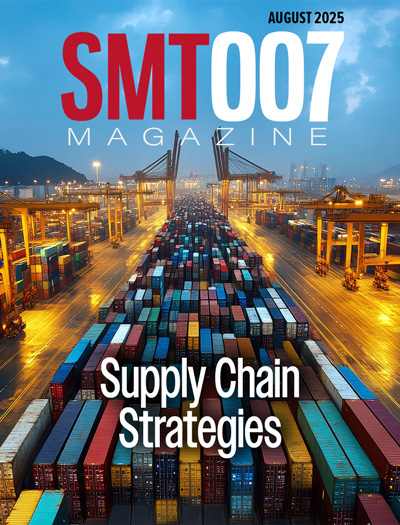-

-
News
News Highlights
- Books
Featured Books
- smt007 Magazine
Latest Issues
Current Issue
Production Software Integration
EMS companies need advanced software systems to thrive and compete. But these systems require significant effort to integrate and deploy. What is the reality, and how can we make it easier for everyone?

Spotlight on India
We invite you on a virtual tour of India’s thriving ecosystem, guided by the Global Electronics Association’s India office staff, who share their insights into the region’s growth and opportunities.

Supply Chain Strategies
A successful brand is built on strong customer relationships—anchored by a well-orchestrated supply chain at its core. This month, we look at how managing your supply chain directly influences customer perception.
- Articles
- Columns
- Links
- Media kit
||| MENU - smt007 Magazine
Intertronics: How to Specify a Dispensing Robot to Increase Quality and Cut Costs
July 3, 2018 | IntertronicsEstimated reading time: 2 minutes
Automated application of adhesives, potting compounds or encapsulants, sealants, FIP gaskets, temporary masking, lubricants, or other liquids, fluids or pastes provides productivity benefits over manual application, including consistency, speed and accuracy. As selection of a dispensing robot is sometimes a daunting task, Intertronics, a specialist adhesives and dispensing company, has compiled a short piece of guidance on how to specify a dispensing robot. The full guidance can be found on their blog at www.intertronics.co.uk/specify-robot.
When specifying a dispensing robot, it is important to understand that a so-called dispensing robot consists of four main components: the robot itself; the dispensing equipment; tooling to attach the dispenser to the robot and to hold the parts to be dispensed on; and an enclosure to protect both the robot and its users. Each of these components can be specified separately, but need to be compatible with each other to ensure a complete and fully operational system. The equipment supplier should be able to assist with this, and may have suggestions for a complete system based on the customer’s application.
The list of considerations for the components of a dispensing robot include work area, Z height, number of axes, weight of parts, weight of payload, load/unload process, accuracy, tolerance and repeatability. All of these are explained in greater detail, along with leading questions, in the full guidance.
Depending on application requirements, there are several dispensing methodologies to consider. The supplier should be able to help discern the most suitable methodology for the application and requirements, as well as with assembly and integration of the completed dispensing robot.
Once the dispensing robot has been specified, purchased and delivered, full training should be given to all users. This may be available from the equipment supplier.
Explains Intertronics M.D. Peter Swanson, “Automating the dispensing process can have significant effects on productivity and product quality. Robots, particularly benchtop robots, offer fast return on investment and a good level of capability when coupled with appropriate dispensing equipment. We have seen substantial improvements in consistency, speed, accuracy and reliability of the dispensing process with our customers who have implemented automated dispensing. This leads to cost savings in materials, production times and reduced rework.
“We have compiled “How to specify a dispensing robot” to help others toward that first step in the process, but we are also happy to walk through the specification process in detail with technology manufacturers who are considering automating their dispensing process. We can, of course, supply all of the components as a completed robotic dispensing system with process integration and training.”
Testimonial
"Our marketing partnership with I-Connect007 is already delivering. Just a day after our press release went live, we received a direct inquiry about our updated products!"
Rachael Temple - AlltematedSuggested Items
OSI Systems Reports Fiscal Q1 2026 Financial Results
10/31/2025 | BUSINESS WIREOSI Systems, Inc. announced its financial results for the first quarter of fiscal 2026.
Aircraft Wire and Cable Market to surpass USD 3.2 Billion by 2034
10/30/2025 | Global Market Insights Inc.The global aircraft wire and cable market was valued at USD 1.8 billion in 2024 and is estimated to grow at a CAGR of 5.9% to reach USD 3.2 billion by 2034, according to recent report by Global Market Insights Inc.
David Schild Addresses Printed Circuit Board Issues as a Panelist at AUVSI
10/30/2025 | PCBAAOn October 28, Printed Circuit Board Association of America executive director David Schild appeared on a panel at the Association for Uncrewed Vehicle Systems International (AUVSI) conference on the topic of “First Supply Chains: Strengthening the Industrial Base for Autonomy.” PCBAA sponsored the event and Schild shared his views on issues facing the American microelectronics industry.
Real Time with... SMTAI 2025: Koh Young's Innovations in SMT Inspection Technology
10/30/2025 | Real Time with...SMTAIJoel Scutchfield discusses his background as well as Koh Young's advancements in inspection technology. The conversation covers various inspection systems, including the flagship Zenith 2 system and recent software upgrades.
BAE Contract Agreed with the Republic of Türkiye for Typhoon Aircraft
10/28/2025 | BAE SystemsThe UK Government has announced a c.£5.4 billion agreement with the Republic of Türkiye for the purchase of 20 Typhoon aircraft and an associated weapons and integration package, sustaining more than 20,000 highly skilled jobs across the UK supply chain.


